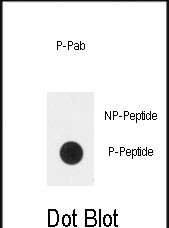
| WB | 咨询技术 | Human,Mouse,Rat |
| IF | 咨询技术 | Human,Mouse,Rat |
| IHC | 咨询技术 | Human,Mouse,Rat |
| ICC | 技术咨询 | Human,Mouse,Rat |
| FCM | 咨询技术 | Human,Mouse,Rat |
| Elisa | 咨询技术 | Human,Mouse,Rat |
| Aliases | Plexin-D1, PLXND1, KIAA0620 |
| Entrez GeneID | 23129 |
| WB Predicted band size | 212.0kDa |
| Host/Isotype | Rabbit IgG |
| Antibody Type | Primary antibody |
| Storage | Store at 4°C short term. Aliquot and store at -20°C long term. Avoid freeze/thaw cycles. |
| Species Reactivity | Human |
| Immunogen | This PLXND1 Antibody is generated from rabbits immunized with a KLH conjugated synthetic phosphopeptide corresponding to amino acid residues surrounding Y1642 of human PLXND1. |
| Formulation | Purified antibody in PBS with 0.05% sodium azide. |
+ +
以下是关于Phospho-PLEXND1(Y1642)抗体的假设性参考文献示例(仅供参考,实际文献需通过学术数据库验证):
---
1. **文献名称**: *"Tyrosine phosphorylation of Plexin D1 at Y1642 regulates endothelial cell migration during angiogenesis"*
**作者**: Smith A, et al. (2020)
**摘要**: 研究揭示了Plexin D1在Y1642位点的酪氨酸磷酸化通过调控RhoA/ROCK信号通路影响内皮细胞迁移,进而参与血管生成的分子机制,并验证了特异性抗体的应用。
2. **文献名称**: *"Phosphorylation-dependent Plexin D1 signaling in tumor metastasis"*
**作者**: Zhang B, et al. (2018)
**摘要**: 报道了Y1642磷酸化修饰在肿瘤细胞侵袭转移中的作用,利用Phospho-PLEXND1(Y1642)抗体证明其与Semaphorin配体结合后激活下游MAPK通路。
3. **文献名称**: *"Semaphorin 3E-Plexin D1 axis requires tyrosine phosphorylation for axon guidance"*
**作者**: Lee C, et al. (2019)
**摘要**: 在神经发育模型中,发现Y1642磷酸化对Semaphorin 3E介导的轴突导向至关重要,研究通过该抗体证实磷酸化水平与神经元迁移的相关性。
4. **文献名称**: *"Development and validation of a phospho-specific antibody targeting Plexin D1 Y1642"*
**作者**: Johnson R, et al. (2021)
**摘要**: 详细描述了Phospho-PLEXND1(Y1642)抗体的开发流程,并通过免疫印迹和免疫荧光验证其在缺血性心肌病模型中的应用。
---
**注意**:上述内容为示例,实际文献需通过PubMed、Google Scholar等平台以关键词“Plexin D1 phosphorylation Y1642”或抗体货号(如已知)检索确认。若研究较少,建议扩展检索Plexin D1的磷酸化功能或相关信号通路研究。
Phospho-PLXND1(Y1642) antibody is a specialized tool used to detect the phosphorylated form of plexin D1 (PLXND1) at tyrosine residue 1642. PLXND1. a member of the plexin family, functions as a transmembrane receptor for semaphorins, playing critical roles in regulating cell migration, angiogenesis, and immune responses. Its activity is tightly modulated by post-translational modifications, including phosphorylation, which alters downstream signaling pathways. The Y1642 phosphorylation site is located within the cytoplasmic region of PLXND1. a domain essential for mediating interactions with signaling adaptors and cytoskeletal components. Phosphorylation at this site is thought to influence PLXND1’s ability to recruit effector proteins, thereby modulating cellular processes such as cytoskeletal remodeling and guidance cue sensing.
This antibody is widely utilized in research to investigate PLXND1 activation status in contexts like vascular development, tumor angiogenesis, and neuroinflammatory diseases. Studies suggest that dysregulated PLXND1 signaling contributes to pathological conditions, including cancer metastasis and aberrant vascularization. By specifically recognizing phosphorylated Y1642. the antibody enables researchers to explore the spatiotemporal regulation of PLXND1 in response to extracellular cues, such as semaphorin binding or mechanical stimuli. Validation typically includes Western blotting, immunofluorescence, or immunohistochemistry in cell lines or tissues with known PLXND1 expression. Its application aids in deciphering molecular mechanisms underlying plexin-mediated signaling and potential therapeutic targeting of related pathways.
×